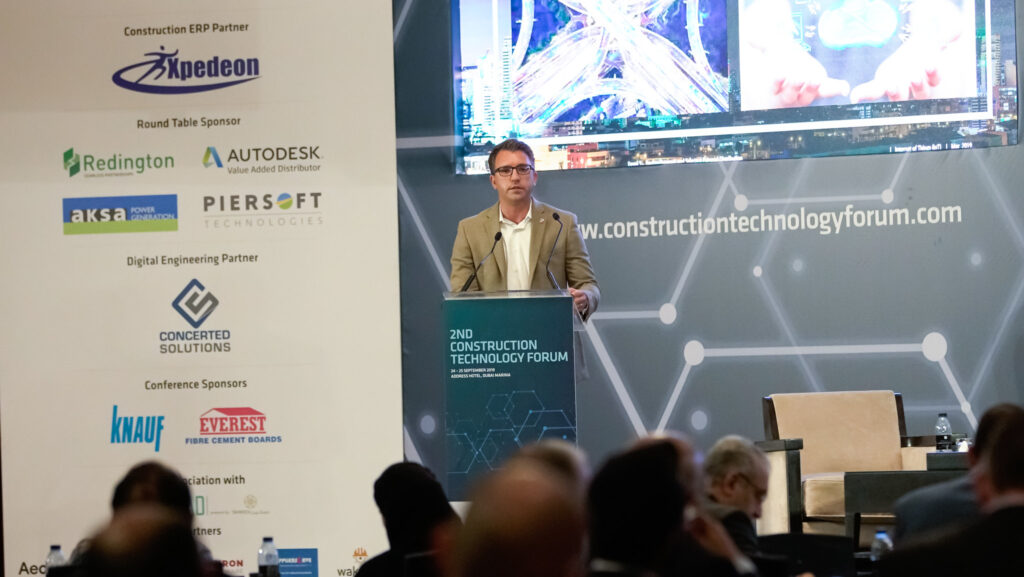Getting employee buy-in and putting in place training and clear policies around how data is treated is critical for successful business change
One of the fundamental changes happening to the construction industry – and the job site – is the drive for its digitisation. Whilst this has been a slower evolution in the Middle East than regions such as Europe and the US, it is taking hold and will disrupt practices and approaches to work, from planning through execution and delivery to managing a building post-completion.
Data that can be analysed and turned into intelligence is the goal of many global industries, and the construction sector has by its own admission been slower to embrace this. The use of intelligent information can not only be used to make more informed decisions, but also understand the flow of a job and where barriers occur (and how they can be overcome). It can improve safety on site, streamline early-stage planning and reduce energy and staff costs, particularly post-handover.
Digital transformation has only just started to disrupt the construction sector and will take many forms. Some are already in use. It is no longer unusual for drones to feedback site information during the construction process. The use of BIM is extending, and this will be the foundation for many construction projects in future.
There is some early-stage use of monitoring staff on the construction site and the Internet of Things (IoT), coupled with sensors, sending real-time information to those in the field and in the back office are both in their infancy. For projects around the Middle East – and the giga projects being planned in Saudi Arabia – it is difficult to see how these will be executed and completed in future without the widescale embrace of disruptive technologies.
To embrace these changes, new processes need to be in place and the people who will use them included at each step, to ensure they are taken on the journey – in some cases influencing decisions on the route that journey takes.
People will be one of the core challenges to change. Business history is littered with failed technology projects because the people who would use the system were not involved early enough, their processes and requirements not well understood and buy-in not sought where changes in practice were required. For any digital transformation, the end users are critical for its success.
“[For] the people out at construction sites who don’t want to use anything, how do you get their buy-in to actually use systems and be part of the overall process?” asked Janak Vakharia, CEO, Algorithms Software during the Construction Technology Forum (CTF). “That is arguably the biggest challenge for most organisations. It is very easy to put an accounting or procurement system in but to get transformation out on the field at project sites, that is the biggest challenge. Once you crack that problem within your organisation, that is where the real transformation happens.”
Clean data essential for decision making
For any construction company undergoing a real digital transformation, KPIs should be set for each goal. Understand the process and if the right people are in place. Bring all the process controls into one place – such as project controls, planning, scheduling, financials, bidding and HR.
“Digital transformation is an agile process. It is ongoing and repeatable, and it is not a project where you bring in a champion or a sponsor, have a couple of meetings at the beginning and then everybody disappears. If you want success, you have to understand it is an ongoing process,” says Sherief Elabd, Director, Industry Strategy & Innovation at Oracle Construction & Engineering.
To succeed, data must be clean and consistent, which is not always easy to achieve. Different people will have differing views on what information is important. They may have different understandings on what should be included and maybe unknowingly add their own bias on the information that is input. But if that data is influencing business decisions, a company needs to be sure it is reliable.

This was echoed by Keith Churchill, Construction Technology and Innovation Manager at Bechtel. He told delegates at CTF: “People make mistakes. They withhold data both knowingly and unknowingly. This can influence decision making wrongly, because it is based on the information provided.”
Training and communication
Internal training and clear messaging for staff on what data is required, why and how it will be used can help overcome this barrier and concerns about any impact this may have on staff. Most people do not deliberately feed in wrong information, so where data is coming through unclear, quick action is required to correct it. With any training, it may be helpful to remove the word ‘digital’ from communication.
It is also worth looking for new systems where early benefits can be achieved, rather big, long-term projects. For the business to continue to believe IoT is the way forward, for instance, seek a project that will quickly show tangible results that can help the bottom line.
Bechtel for instance understood that for different parts of the business to take IoT seriously, it needed some quick wins where people could see clearly the benefit it brought to processes. The company focused on the movement of materials, using RFID-tags, during their journey from supplier to site, using smartphones to gather information and created blockage reports. These were used by all teams to input information on what was holding them up, with the information going directly to management. It meant progress meetings could focus on how to remove the blocks that were delaying a job, using factual information to inform decisions.
That the job site is changing is not under discussion. For the Middle East, the change is still in its early stages, but this will accelerate, particularly as there are more examples of success. Highlighting that the people who will use the systems are critical to that success is an obvious statement, but its importance cannot be emphasised enough. Too often projects run at full pace without considering the system users; their knowledge can introduce new ideas and improvements and their buy-in – especially from those who are being monitored or inputting data – is essential to ensure the intelligence gleaned is accurate.















